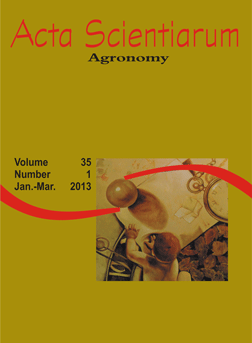<b>Association between glucosinolate concentration and injuries caused by cabbage stink bugs <i>Eurydema</i> spp. (Heteroptera: Pentatomidae) on different Brassicas</b> - doi: 10.4025/actasciagron.v35i1.15622
Resumo
In 2010, we were determining the contents of glucosinolates in different Brassicas in order to study their influence on feeding of cabbage stink bugs (Eurydema spp.) and the consequent extent of damage. We confirmed that glucosinolates content depends on plant species, plant organs and the time of sampling. In the samples aliphatic glucosinolates (glucoiberin, progoitrin, epiprogoitrin, epiprogoitrin, sinigrin, gluconapin, glucoraphenin, sinalbin) prevailed. Glucobrassicin, an important indolic glucosinolate compound, was detected in all tested Brassicas. Its concentration in the oil radish samples was highest during the first assessment (30 DAS), 8.84 ± 0.65 µmol g-1 ds, while the oilseed rape samples displayed lowest concentration during the last assessment (134 DAS), 4.30 ± 0.80 µmol g-1 ds. The stimulative activity of individual glucosinolates or their negative influence on feeding of cabbage stink bugs in the Brassicas used in our experiment was not uniformly manifested. Based on a two-year field experiment we concluded that oil rape was the most adequate trap crop used to allure cabbage stink bugs. In future, glucosinolates should be employed to a greater extent in environmentally acceptable ways of food production, one of which is also the use of trap crops in order to reduce harmful effects of cabbage stink bugs.
Downloads
DECLARAÇÃO DE ORIGINALIDADE E DIREITOS AUTORAIS
Declaro que o presente artigo é original, não tendo sido submetido à publicação em qualquer outro periódico nacional ou internacional, quer seja em parte ou em sua totalidade.
Os direitos autorais pertencem exclusivamente aos autores. Os direitos de licenciamento utilizados pelo periódico é a licença Creative Commons Attribution 4.0 (CC BY 4.0): são permitidos o compartilhamento (cópia e distribuição do material em qualqer meio ou formato) e adaptação (remix, transformação e criação de material a partir do conteúdo assim licenciado para quaisquer fins, inclusive comerciais.
Recomenda-se a leitura desse link para maiores informações sobre o tema: fornecimento de créditos e referências de forma correta, entre outros detalhes cruciais para uso adequado do material licenciado.




















































